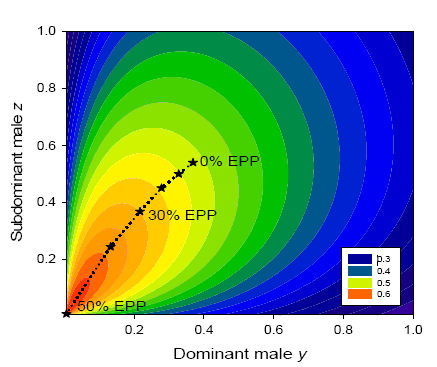Female infidelity enhances male cooperation
BIO researcher, Sigrunn Eliassen proposes this as a new hypothesis to a long-standing conundrum in sexual selection theory. By offering an explanation to patterns in nature that have proven difficult to interpret, understand, and predict with existing theory, the FriBIO evaluators in 2008 clearly agreed with Eliassen that her work has the potential for significant impact.
Main content
Eliassen’s FriBIO project is a double success. She first applied in 2007, but was not successful. She worked to improve the application, and it was granted funding in 2008.
Eliassen explains that under-standing the adaptive value of mate choice and extra-pair mating behaviour is important, not only because it influences the strength of sexual selection, but also because it is fundamental to population dynamics and the evolution of a variety of life-history traits. Her hypothesis is that “female infidelity may enhance male cooperation in collective predator defence or sharing of resources, thus providing direct benefits to all the female’s offspring. In short, the more off-spring a male sires in different nests, the more he will be looking out for potential nest predators or be willing to share resources that benefit those offspring.”
Eliassen says she and a few other researchers in the field feel that there has been an extensive focus on genetic benefits for several decades, but that now it may be time to consider other mechanisms that might drive the evolution of female choice. She says that her project will focus on two partially neglected factors of importance for offspring growth and survival, and where the level of female infidelity has a potentially modulating effect on the outcome:
- cooperative predator defence in breeding aggregations
- resolving conflicts over resources
Eliassen feels that resolution of these questions depends on better understanding how
i. mating strategies are influenced by social interactions and spatial arrangement,
ii. cooperation and conflict affect male and female investments,
iii. breeding strategy depends on individual condition, and
iv. ecological factors such as predation and resource availability affect trade-offs in reproductive investments.
Such a list suggests that factors affecting levels of extra-pair paternity, spatial organization of breeders and the negotiation of investment in parental care may be more complicated than is currently acknowledged. She says that studying the co-evolutionary process of mating strategies, parental investment, and cooperation is therefore essential to fully understand each phenomenon.
Eliassen and her co-workers have divided the main hypothesis into a set of research questions that can be addressed separately. This will enable the project to increase complexity in a step-wise manner, starting with simple conceptual models that explore the basic assumptions of the hypothesis. The aim is a modelling framework where female mating strategies, male investment in territoriality, mate guarding or collective predator defence are all evolving traits.
Hypothesis: Female infidelity stimulates male cooperation to provide direct fitness benefits for her offspring, through predator defence or access to resources
RQ1 Does female infidelity promote cooperative predator defence?
RQ2 How do individual differences in competitive ability affect paternity distributions?
RQ3 How will parental investments vary with condition and future mating prospects?
RQ4 Do males signal territory holding power and investment in antipredator behaviour?
While the results will hopefully provide basic insights for the scientific community of evolutionary ecologists, on a more general level, Eliassen says that elucidating the basic dynamics of mate choice and sexual conflicts may provide insights into central aspects of cooperation and conflict in many animal species, including humans. She says that understanding the adaptive value of mate choice is fundamental to population dynamics and thus will have implication for management and conservation biology.
In the current climate of “equal opportunity”, Eliassen is also a positive role model for women in science, having been selected to lead such an ambitions basic research project relatively early in her scientific career. Her project also provides valuable opportunities for strengthening collaboration between young and experienced scientists, naturally of both sexes!
*this article is strongly based on Eliassen’s NFR application.
